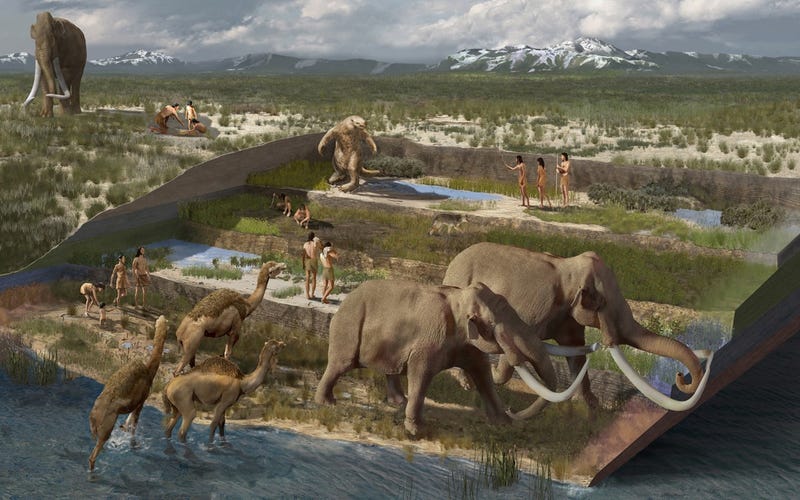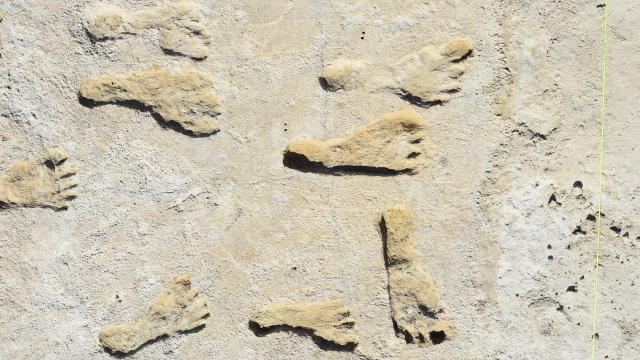Fossilized human footprints at White Sands National Park in New Mexico are every bit as old as the 23,000 years-and-change they were dated at in 2021, according to analysis published in Science.
Back in 2021, researchers published work in which they used radiocarbon dating of crushed seeds of Ruppia cirrhosa, an aquatic grass, to date the preserved footprints to between 23,000 and 21,000 years old, which would make them thousands of years older than the next most recent evidence of humans in North America. That finding was exciting, but scientists looked for a way to be more certain of the prints’ age. Now, they’ve done it: a group, including members of the previous collaboration, has dated pollen and sediments from the site to the same timeframe as the ancient grasses.
Footprints are a telltale sign of a hominin presence, if not Homo sapiens. In 2020, a team found fossilized footprints in Saudi Arabia that they said could belong to our species and which date to about 120,000 years ago. If they were made by Homo sapiens, the trackways could reveal one route out of Africa for our ancestors. But the prints could also have belonged to Neanderthals, whose oldest confirmed footprints date to just over 100,000 years ago and were spotted on a Spanish beach in 2020.
But the White Sands footprints are arguably more controversial than the prints from the Middle East and Europe. These belonged to a group of humans that likely included teenagers and children, based on their sizes, who were probably moving across the land at a typical walking pace. Proboscidean (mammoth or mastodon) and dire wolf prints are also on the site. As Jeanne Timmons reported for Gizmodo in 2021, when the prints were first dated:
It’s a stunning revelation that indicates humans lived in areas below the ice sheets covering much of North America and the world at that time, evidence that could change our understanding of when people arrived on this continent, where they migrated, how they impacted the ecosystem, and how they responded to climate change.
“We always knew that we would have to independently evaluate the accuracy of our ages to convince the archaeological community that the peopling of the Americas occurred far earlier than traditionally thought,” said study lead author Jeffrey Pigati, a geologist with the U.S. Geological Survey, in an American Association for the Advancement of Science release.
There are several hypotheses for when humankind first appeared in North America. One view is that our species didn’t arrive until after the Last Glacial Maximum (LGM), between 16,000 and 14,000 years ago, when the frigidness of the Pleistocene finally began to thaw, giving way to the Holocene Epoch. The idea is that glaciers would have impeded human expansion across the continent—during the LGM, about 25% of Earth’s land was covered in ice. But the White Sands footprints, if dated correctly, clearly indicate that Homo sapiens were in the American Southwest before the ice sheets began to recede.
“Although we were confident in the original seed ages, we wanted to develop community confidence in them as well,” said Kathleen Springer, also a geologist with the USGS, in the same release. “Our new ages, combined with the strong geologic, hydrologic, and stratigraphic evidence, unequivocally support the conclusion that humans were present in North America during the last Glacial Maximum.”

Radiocarbon dating is a reliable way of dating ancient organic material, but it has shortcomings. Aquatic plants can photosynthesize atmospheric carbon that’s made its way into the water, but they can also take up more ancient carbon from the groundwater, meaning that analyzing the plant remnants with radiocarbon dating can yield an older age than what the plants actually are. This is known as the freshwater reservoir effect. Additionally, the plants themselves may be more ancient than the sediments they’re found in, if they were redeposited in younger geological layers.
In the new research, the team radiocarbon dated pollen from the same layers as the Ruppia seeds. Pollen is not affected by the freshwater reservoir effect. The team also conducted optically stimulated luminescence dating of the sediment, which dates layers of the ground by determining when some minerals in the soil were last exposed to light (i.e. when they were last on the surface).
“The interpretation of the results seems sound,” Rainer Grun, a geochronologist and former director the Australian Research Centre for Human Evolution, in an email to Gizmodo. “The good agreement between the seed and pollen results refute the argument of reworking of the seeds.”
The pollen dates ranged from 23,400 years ago ± 2,500 years to 22,600 years ago ± 2,300 years; the sediment dating yielded a minimum age of 21,500 years old ± 1,900 years. In other words, two additional lines of evidence to the radiocarbon dating of the Ruppia plant material corroborate the team’s initial findings two years ago.
“Even allowing for substantial errors in radiocarbon dating and OSL, the data overall from the Pigati et al. study strongly indicate human presence in the Americas around the LGM,” wrote Bente Philippsen, an archaeologist at the National Laboratory for Age Determination at the Norwegian University of Science and Technology, in a related Perspectives article.
Older dates have been posited for a human presence in North America. In 2017, a team of researchers suggested there was evidence of human activity on the continent a staggering 130,000 years ago, a claim that received widespread pushback. In 2020, two studies in Nature described stone tools and flakes in a Mexican cave that were dated to about 31,000 years old, and last year, an apparent mammoth butchery site in New Mexico was dated to about 37,000 years old—15,000 years older than the White Sands footprints.
Trace fossils provide a different, more intimate window into the past than bones or teeth. A collection of footprints show not just that people were present, but how many there were, whether they were children or adults, and where they were going. Superlative age aside, the White Sands footprints are a marvelous echo of some of the earliest Americans. At least, some of the earliest we know of for now.
